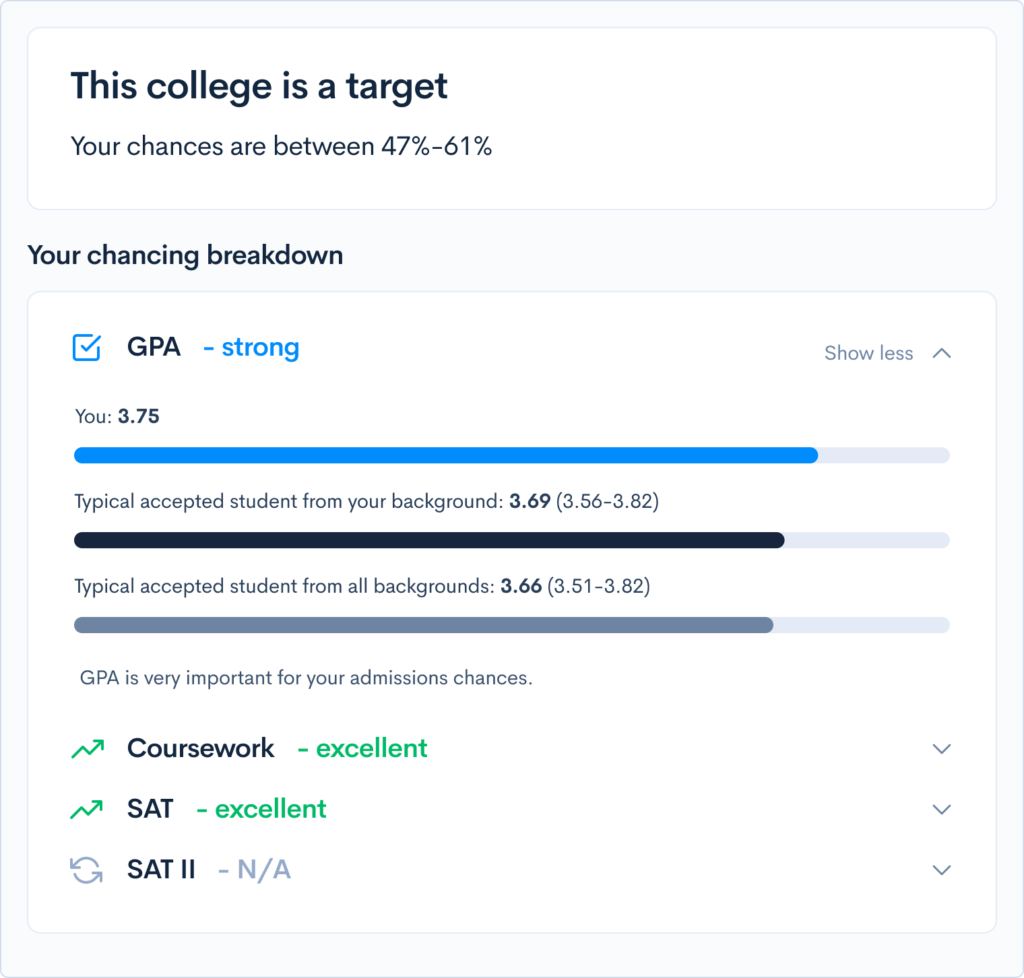D1 vs. D2 vs. D3: What’s the Difference?
What’s Covered:
- Why Are There Different Divisions?
- Differences Between Divisions
- Which NCAA Division Is Best For You?
- Should Sports Impact Your College Decision?
- What Are My Chances of Acceptance?
Understanding the difference between D1, D2, and D3 athletics is important for all types of students—from student-athletes trying to decide which school gives them the best odds of playing in college to sports-crazed students who simply want to attend a school with a big-time athletic program. Keep reading for a breakdown of D1 vs. D2 vs. D3 to learn the differences between the divisions and how to find the right division for you.
What is the NCAA?
The National Collegiate Athletic Association (NCAA) is a member-driven organization that supports learning through the integration of sports and higher education. The association enriches the college experience of student-athletes and helps ensure they are given the tools to succeed in the classroom, on the field, and throughout their lives.
The NCAA is made up of members, most of whom are colleges and universities, but conferences and other affiliated groups are also represented. More than 1,000 colleges made up of nearly 500,000 student-athletes play within its 100+ athletic conferences. NCAA members create rules to make sure competitions are safe and fair, organize national championships, and work toward the long-term goal of college success.
Why Are There Different Divisions?
The NCAA’s three divisions help create parity and ensure a competitive playing field in college sports—for example, it’s only fair that a giant state school like UCLA, which has more than 30,000 undergraduates and enormous resources, competes against schools with a comparable level of investment in sports and athletes of similar abilities.
Another benefit of the NCAA’s divisions is that they enable small schools (and schools with fewer resources) to compete for championships. The system also allows athletes of disparate abilities to play a sport at a college level. For instance, just one in 23 students at a Division 1 school is an athlete; at a Division 2 school, the ratio shrinks to one in six.
If you want to know which division a certain school is a part of, CollegeVine has created a complete list of D1, D2, and D3 colleges.
The Differences Between D1 vs. D2 vs. D3
Division 1
D1 schools are commonly home to the best athletes in college sports and are normally the choice for student-athletes with aspirations of pursuing their sport professionally. On average, D1 schools are the nation’s biggest institutions and have the largest enrollments. The median undergraduate enrollment at a D1 school is 8,960 students, which is more than five times greater than that of a D3 school that has 1,740 students. D1 schools have large budgets, offer a wide variety of sports, and provide the most athletic scholarships.
While most D1 schools provide more athletic scholarships than their D2 and D3 counterparts, the schools of the Ivy League, which are Division 1, are the exception to the rule. These schools award neither athletic (nor academic) scholarships.
Division 2
D2 takes a more balanced approach to athletics and academics and consequently requires a lower level of commitment than at D1 schools. In general, D2 schools are mid-sized—the median enrollment is 2,428 and one in 10 students is an athlete. A D2 school’s athletics programs are financed in the institution’s budget like other academic departments on campus. Schools offer partial scholarships to D2 student-athletes, which are often paired with academic aid and need-based grants to fund college.
Division 3
D3 encompasses a wide range of schools. To give you an idea, the largest D3 school has over 25,000 undergraduates while the smallest has just over 400. This division is also home to the greatest number of schools (438) and the highest percentage of students who are athletes (one in six). Colleges fund D3 athletic programs like they do other departments and students do not receive scholarships based on their athletic ability. D3 sports are focused on the student-athlete experience (in contrast to the fan experience) and encourage institutions to maximize the athletic opportunities available to their students.
|
Division |
Number of Schools |
Average School Size |
Ratio of Student-Athletes to Students |
Percentage of Athlete Who Receive Scholarships |
|
Division 1 |
350 |
8,960 |
1:23 |
57% |
|
Division 2 |
310 |
2,428 |
1:10 |
60% |
|
Division 3 |
438 |
1,740 |
1:6 |
0% (but 80% of athletes receive non-athletic aid) |

Which NCAA Division is Best for You?
We all have different interests and sports may or may not be high on the list. Which athletic division you aim for depends on how central you want sports to be in your college career. D1 is thought of as the most competitive division with the best athletes and teams and requires an enormous amount of dedication—there’s travel, off-season workouts, and even weekend commitments. Many talented athletes choose D2, some for a more well-rounded college experience and others for the opportunity to get more playing time or to play all four years. D3, in general, provides a student-athlete with a “normal” college experience while allowing them to still compete in athletics.
It’s also common for non-athletes to make their college decision based on a school’s sports program. For example, some football fanatics choose D1 schools in Power Five conferences—five athletic conferences that are known as elite in football—to experience big Saturday games and stadiums packed with students.
Should Sports Impact Your College Decision?
If athletics are important to you, they should factor into your college decision. But they should be just one consideration and less of a concern than academics. Other things to think about besides sports when choosing a college include:
Fit: Does the school match your ideal vision of what college should be like? For example, is it the right distance from home, in the right setting; does it have the right sized student body; does it offer the classes you want to take?
Finances: What will it cost to earn a degree and what is the return on your investment?
In the end, students who choose a school that meets their fit and financial needs have the best college experiences and graduate positioned for success after school.
What Are My Chances Of Acceptance?
Are you unsure which school you want to attend, or what your odds are of getting accepted into a particular school? CollegeVine can help.
Our free chancing engine uses a host of factors to estimate your odds of acceptance at hundreds of schools while our school exploration tool allows you to search colleges using a variety of filters, including if a school has a D1 football or basketball program, and what conference a school plays in. All you have to do is make an account to start searching!


